Structureseal is a highly effective waterproofing composite, of high strength green coloured geotextile, and sodium bentonite.
BENEFITS
- Pre-applied tanking systems
- Suitable for wet weather and low temperature applications
- Quick and easy to apply
- Does not require additional drainage or protection
- Primers and adhesives not required
APPLICATIONS
- Basements and sub-structures
- Retaining walls
- Ground floors
APPLIED TO
- Concrete
- Compacted earth
- Sand blinding
- Formwork
- Piling
Typical uses
The high swelling sodium bentonite is encapsulated between a non-woven and woven geotextile. A ‘needlepunch’ process, interlocks the geotextiles together forming an extremely strong composite that maintains the equal coverage of bentonite, as well as, protecting it from inclement weather and construction related damage. When wetted, unconfined bentonite can swell up to 15 times its dry volume. When confined under pressure the swell is controlled, forming a dense, monolithic, impervious waterproofing membrane. The swelling action of Structureseal can self-seal small concrete cracks caused by ground settlement, concrete shrinkage, etc. Structureseal forms a strong mechanical bond to concrete, when the geotextile fibres are encapsulated into the surface, of insitu concrete. Structureseal contains zero VOC’s (Volatile Organic Compounds) and can be installed in almost any weather condition. Structureseal is designed for below ground vertical and horizontal structural foundation surfaces. Typical applications, include backfilled concrete walls, structural slabs and boundary line construction. When designing Type A structures (as classified in BS 8102:2009), the system installed correctly is capable of providing the levels of protection required for Grades 1, 2 & 3 basements. Boundary line construction applications, include secant and contiguous piling, skin wall, metal sheet piling, sprayed concrete finishes and stabilized earth retention walls. Applications may include structures under continuous or intermittent hydrostatic pressure. Notes: Structureseal is not recommended to waterproof masonry construction, and must never remain permanently exposed. The ‘gelling’ of Structureseal is adversely affected by the presence of electrolytes, and if present, or the product is being used in chemically contaminated areas, the system should be pre-hydrated prior to placing concrete or backfilling. Backfill material should not contain chalk or limestone, unless the product is pre-hydrated.
Durability
Subject to normal conditions of use Structureseal will provide an effective barrier to the transmission of liquid water and water vapour for the life of the structure
SPECIFICATION
J40 - Flexible Sheet Tanking/Damp Proofing in accordance with NBS Clause 285. Please consult RIW for further information.
INDEPENDENT AUTHORITY
Structureseal, as a system, has been awarded a British Board of Agrément Certificate No. 02/3953 covering its use in waterproofing and damp-proofing underground structures.
ANCILLARY PRODUCTS
RIW produce a range of ancillary products for use with Structureseal which include:
Waterstop - a flexible, expanding bentonite-based waterstop, for use in non-moving concrete construction joints. See separate data sheet.
Sealing Compound - a trowel grade sodium bentonite compound, used as a detailing mastic around penetrations and corner transitions. See separate data sheet.
Granules - chemically treated sodium bentonite granules, which swell upon contact with water, and are used as a detailing accessory product. See separate data sheet.
Washers - a ‘soft-washer’ fastener, (40mm hardened nail with 30mm diameter pre-mounted washer) for securing the Structureseal to concrete, etc, by hand nailing or shot-firing.
Staple Gun - a manual stapler, for fixing sheets of Structureseal together at lap positions, etc.
Cementseal - cement base waterproof coating applied by hand or spray as a continuity membrane through the foundation bearing plane.
PERFORMANCE & COMPOSITION
| Property | Test Method | Typical Value |
| Bentonite Mass per Unit Area | ASTM D 3776 (modified) | 4.88 kg/m |
| Peel Adhesion to Concrete | ASTM D 903 (modified) | 2.5 kN per metre width |
| Hydrostatic Pressure Resistance | ASTM D 5385 (modified) | 70 metres |
| Permeability | ASTM D 5084 | 1 x 10-9 cm/sec |
| Grab Tensile Strength | ASTM D 4632 | 422 N |
| Puncture Resistance | ASTM D 4833 | 445 N |
| Low Temperature Flexibility | ASTM D 1970 | Unaffected at -32°C |
The above performance figures are typical values and should not be considered a product specification.
CONSTRUCTION
GENERAL
All construction should conform to the Building Regulations, Codes of Practice and British Standards in current use at the time the building is being constructed. In particular it is recommended that reference is made to BS 8102: 2009.
PREPARATION
Floors: Substrate should be smooth and compacted as necessary to a minimum of 85% modified proctor density. Concrete surfaces should be free of voids and sharp projections. Surface irregularities should be removed before installation.
Walls: Honeycombing and other surface voids must be filled with a suitable strength mortar, or Sealing Compound as necessary. Bolt holes must be filled with a proprietary non-shrink mortar or grout, as necessary.
Boundary Line Construction: General, gradually undulating surfaces are acceptable, sudden changes in level, such as ridges and hollows, are not. Concrete surfaces shall be free of large voids or projections. Voids, pits, and cracks in excess of 20mm, shall be solid filled to a flush condition, using cement grout, or Sealing Compound to suit. Projections greater than 20mm shall be removed, or smoothed flush.
APPLICATION
General: Install Structureseal, in strict accordance with the installation guidelines, using ancillary products as and where recommended. Install Structureseal, over the properly prepared substrate, with the lighter (woven) geotextile face toward the concrete to be waterproofed, and the dark green (spun) side facing outwards. Overlap all adjoining edges a minimum of 100mm, and stagger adjacent roll ends by no less than 300mm, to avoid four way laps. Staple or nail edges together as required, to prevent any displacement before and during concrete placement. Cut Structureseal to provide a tight fit around all applicable penetrations (pipes, piles, etc). Install Waterstop around all pipes, as a “puddle flange” within the concrete. Finish all penetrations through the Structureseal, with a 40 x 40mm fillet of Sealing Compound, around the cut edges. See Detail 2 & 6. Install Waterstop as necessary in all applicable horizontal, and vertical, concrete construction joints. Horizontal installation surfaces shall be free of excessive* standing water, particularly where a concrete under-blinding layer is not utilised. (* Structureseal can be installed in almost all inclement weather conditions, providing the quality/ accuracy of the installation is not affected, eg. Structureseal, floating, Waterstop submersed etc.) Schedule installation of waterproofing materials to permit prompt placement of backfill material or concrete. For applications not covered below, please contact RIW’s Technical Department for advice and specific installation guidelines.
SPECIFIC USES
FLOOR SLABS
Structureseal is recommended for use under structural reinforced concrete slabs 150mm thick or greater on compacted earth substrate or concrete blinding layer. Install the product around all foundations, (ground beams, pads, pile caps, etc). See Details 1 & 2. Structureseal should not extend into foundation bearing planes (pile caps, ground beams, pads etc), but should completely envelop them. Where this is not possible/desirable, a painted or cement based waterproofing system can be used as a continuity ‘membrane’ through the bearing plane and the product can be sealed to this. See ancillary products. Where a concrete blinding layer is not used, detail an additional 40mm chase filled with Sealing Compound around the penetration under the Structureseal. Where boundary line construction, such as secant/ contiguous piling, metal sheet piling, skin wall, etc, is used as the outside shuttering, continue the under-slab installation, up the boundary line a minimum of 300mm above the top edge of the floor slab, foundation, or kicker level. The extra 300mm is very important since there is no access to the outer edge after the concrete pour, and the top 100mm is to be kept free of concrete splashes etc, to enable a ‘clean lap’ later. See Detail 4.
CONCRETE RETAINING WALLS
Structureseal can be applied to backfilled walls in two ways: mechanically fastening to cast concrete just prior to backfilling (post - applied), or preferably, by utilising the peel-adhesion properties of the system (pre-applied). The needle-punched geotextile fibres, which have been forced from the dark green (spun) side through the bentonite and lighter (woven) side, will be trapped within the wet concrete, and allow the Structureseal to remain firmly attached to the concrete, after the formwork has been removed. All through bolt holes, etc., must be filled, from the outside, using a proprietary non-shrink grout or similar, covered in a “mushroom” of Sealing Compound, either prior to backfilling (pre-fix/peeladhered application), where additional ‘patching’ will be required, using a 200 x 200mm patch. Backfill material shall be of compactable soils, which are free of construction debris. Backfill shall be clean, well graded, and compacted every 300mm, to 85% modified proctor (as defined by ASTM 1557), and meet the following general specifications: • No rocks, stones or boulders, larger than 50mm. • 90% minimum soil particles, smaller than 5mm. • 10% maximum soil particles, finer than 74 microns. (200 mesh) Terminate Structureseal, on the concrete structure, below ground level. Integrate the system with a damp proof course/cavity tray, by means of placing a 300mm wide band of Sheetseal 226, over the termination point, a minimum of 150mm. The lap should be enhanced, by the inclusion of a 50 x 5mm bead of Sealing Compound. Flexiseal should then be lapped over the Sheetseal 226, and be continued up to dpc, as required. See Detail 5.
Pre-Applied: Apply Structureseal to timber formwork, either horizontally or vertically, by nailing or stapling as required. Ensure all laps face downwards, as applicable. Extend Structureseal the full depth of the formwork, so that the product laps 100mm over the Structureseal already cast into the slab edge and wall kicker. Allow no less than 300mm at the top of the formwork, to provide ground slab continuity later, if required. See Detail 2. Position formwork, as required, and tie/space forms, penetrating the Structureseal as necessary. Normal concrete practice is sufficient in terms of striking times for formwork, but due care should be taken to ensure that Structureseal remains bonded to green concrete. Where a slab ‘toe’ exists, and the under-slab Structureseal has terminated at the top edge of slab, additional Structureseal will be required to link underslab/edge of slab Structureseal with wall Structureseal. Apply a 40 x 40mm fillet of Sealing Compound, at the internal wall/slab corner, and place additional Structureseal over the slab toe. This should lap 100mm over the edge of slab Structureseal, and continue over the toe terminating under the un-bonded wall Structureseal ‘flap’ at the back of the kicker. See Detail 1.
Post-Applied: Apply Structureseal vertically or horizontally against concrete, starting with a 100mm lap at the under-slab/edge of the Structureseal (peeladhered to concrete). Use Washers for fixing, and follow the general application guidelines, ensuring that all laps face downwards, as applicable. The lighter (woven) side, should be against the concrete, with the dark green (spun) side facing the installer. Provide a 40 x 40mm fillet of Sealing Compound, at all horizontal and vertical internal corners, prior to application of the Structureseal.
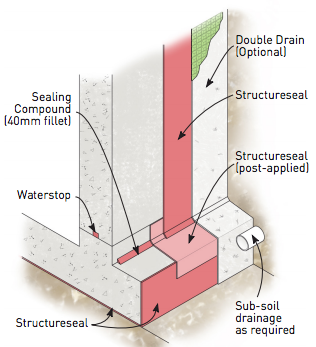
BOUNDARY LINE CONSTRUCTION
Structureseal is used to waterproof various types of boundary line construction, including metal sheet piling, secant and contiguous piling, skin wall, sprayed concrete and stabilizedearth retention walls. See Details 3 & 4. Sprayed concrete finishes can be applied directly onto the Structureseal. When working against the boundary line, always start with the vertical installation, prior to installing Structureseal under the slab. Apply the bottom run of Structureseal lengthways/horizontally against the boundary line construction, approximately 1000mm from the substrate/blinding level, allowing 150mm of Structureseal to extend under the slab. On profiled boundary lines (metal sheet piling, secant and contiguous piling, etc) the 150mm base flap will need to be cut and splayed as necessary, to allow the material to lay flat. Use Washers for fixing, and follow the general application guidelines, ensuring that all laps face downwards, as applicable. Ensure that the Structureseal closely contours the application surface. For secant piling, locate fixings close to cleavages. On contiguous piling, ensure that soil columns between piles are cut back to no less than one third of the pile diameter, to create a fixing cleavage, and reduce the likelihood of soil dislodging behind the membrane. Due consideration should be given to termination levels and details, with reference to the height of any temporary works construction. Cutting down these works after the Structureseal installation/concrete placement, may destroy the waterproofing.
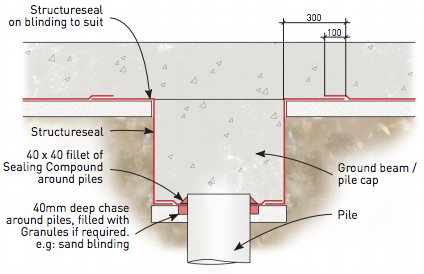
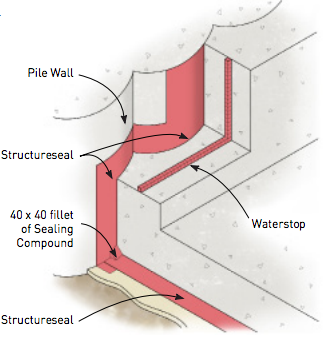
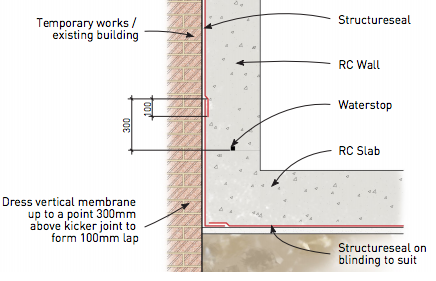
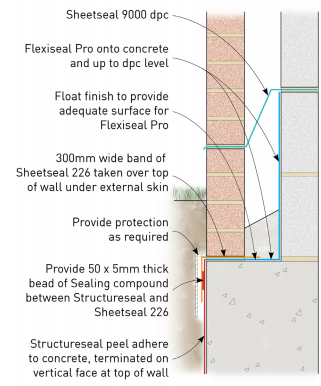
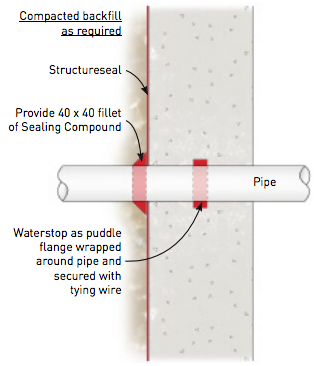
SAFETY
Full health and safety instructions are contained on the product material safety data sheets and these must be referred to before use.
SUPPLY
AVAILABILITY
All RIW products can be obtained through Builders Merchants or approved stockists. A list of approved stockists is available from RIW’s offices.
PACKAGING
Structureseal is 6.4mm thick & supplied in 1.1 wide x 5m long rolls (35 per pallet).
Each roll weighs approximately 35-40kg.
Washers: packaged in boxes of 500 including fixing nails.
Staple Gun & Staples: Gun - packaged singly.
Staples - packaged in boxes of 2500.
STORAGE
Structureseal and all associated ancillary products must be stored in dry conditions, under cover, and away from possible contact with water. Store products above 4˚C, prior to use.
TECHNICAL SERVICES
The RIW Technical Department is available to advise on individual projects and to prepare or assist in the preparation of specifications and drawings. A list of experienced applicators of our materials is available from RIW’s offices.
Download
Click here to download this information in PDF format.




